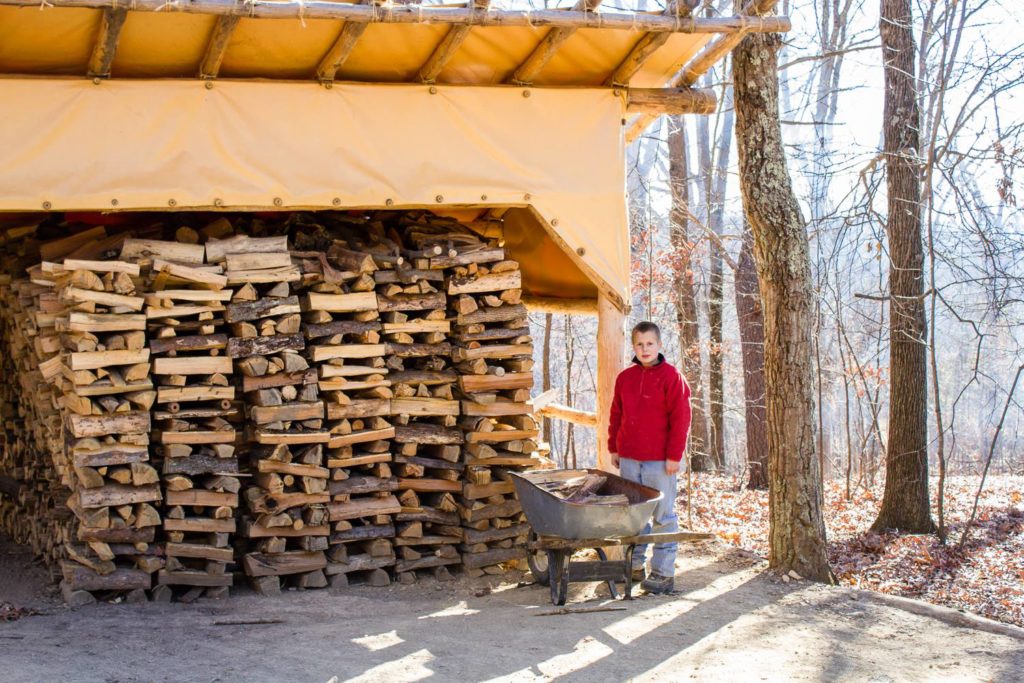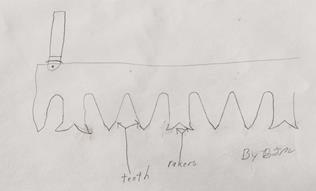
Soon after he arrived, one of the first boys to stay here at Allegany Boys Camp, raised a small complaint because we were expected to cut our firewood with a crosscut saw rather than a chainsaw. You know, after all, he was fast coming to the age when a young man needs to learn to handle a chainsaw, and what better boost could we give his manliness than to offer that blast of noise and power that he could hold with his two hands to “subdue the earth”.
With this in mind, my response to this young man was fortunately one of understanding. I told him that I missed using a chainsaw too when I came to camp. Cutting with a two man saw seemed like an awful lot of work for a little bit of firewood, but I did learn to like using one. After all, I assured him, despite the fact that he probably could handle a chainsaw, not every boy coming to camp could, which would either create an unfair situation or a safety hazard.
I can’t recall whether my answer satisfied him then or not, but it might not even satisfy some of my readers. We live in a time when a premium is placed on efficiency and the very form of heating with firewood itself is controversially inefficient, let alone the idea of cutting it all by hand. In regards to camp, at least someone could give the boys a little boost with a Husqvarna and a hydraulic woodsplitter.
Well like it or not, this young man and I went into the woods, our bucksaws in hand, to cut our firewood with raw man power, learning as we went. How did it go for us?
We learned that our great, great grandfathers were hard workers. You know it never hurt a guy to try something the way his ancestors did. In fact a whole book could be written on the benefits of understanding the rigors of Pioneer life… the boys from camp look with respect into the eyes of those Irishmen staring back at them with grim faces from the pages of historic logging books. These men, standing beside enormous trees that they felled, are not Paul Bunyans. They are average sized men with a whole lot of determination and a wee bit of pride. One thing is sure; they didn’t spend much time lounging around.
We learned to focus and work together. It’s a very frustrating experience to run a saw with a partner who is distracted while he cuts. The saw is sure to be pulled crookedly, jerking and catching all the while. Maybe you will be pulling the weight of the saw and your partners torso. That’s awful.
We learned to move those big logs. It’s amazing how much teamwork it requires to carry a large oak log. It takes a bit of innovation at times when you think that it can’t be done, but you know it must.
We learned to think ahead for ourselves. “Let’s say we’ll burn a wheelbarrow load a day to heat these tents here… that means we’ll probably need at least “x” amount of loads in our wood tent by November.” Planning. Thinking ahead.
We learned the joy and the art of splitting that wood. Wow! Boys at camp love the thrill of raising that axe or maul and bringing it down with a crashing blow straight through a chunk of firewood (talk about subduing the earth). But what about that chunk with an ornery knot in the center. There’s where the mind must be engaged as well as the muscles. It’s possible to learn to read the growth rings and attack that wood in it’s weak point, rewarded again by a satisfying CRACK!
We gave attention to that wood. It’s very common that a camp group pauses their splitting to gather where an interesting find has been made within a piece of wood. Could be it’s a unique grain pattern or configuration that someone sets aside to use for making a craft. Sometimes it’s a shake (yes, I meant shake not snake) or an intriguing color in a particular piece. Maybe there’s a weird beetle lodged in there or more commonly a crevice full of ants. They make a tasty snack by the way, with a burst of lemon flavor, though not very sustaining.
We joked about that wood. It is said at camp that wood cut by hand has twice the value of other wood. “It warms you when you cut it, and warms you when you burn it.”
We sang about that wood. One of the loudest, most hair raising songs at camp is “Everywhere I Go I Cut Wood”.
We stacked and restacked that wood. A good wood stack requires some careful construction. It is a disheartening experience to return to campsite and find your wood that was stacked when you left all sprawled out across the ground in a non-stacked arrangement. At camp, more of us than not have experienced this, and only then are we willing to take the advice of a more experienced stacker and go an extra mile of precaution.
It’s also unfortunate when your firewood emits more hissing and smoke than it does heat, but if it’s not well seasoned this can be the case. We worked ahead and dried that wood.
We conserved that wood too mind you. As with financial matters, the harder one works for something the less likely he is to waste it or spend it carelessly. Our firewood stack was not so different from a bank account.
I can’t tell you how many times I’ve quickly piled a mess of kindling and firewood together and lit it only to come back a few minutes later to find not a crackling blaze but a smoldering lifeless heap. You can count on it that if you try burning very large pieces of wood with too little kindling or have your wood carelessly arranged, your fire will be unsuccessful. We set that wood carefully in our stoves before striking fire to it.
We gathered around that wood as it crackled and popped and blazed. There’s nothing quite like a wood fire to draw folks together, comforted by its warmth, transfixed by its flames. It speaks to something deep within man. All across the land conversations are drawn from within, friendships are deepened and hearts are encouraged by the flickering glow of a well set fire.
So this young man and I, like so many others at camp, found plenty good experiences in gathering our own firewood, cutting it with traditional saws and surviving the winter with its warmth and cheer. At the end of it all, if given the chance to live through those days at camp again with the added assistance of a Husqvarna… we again would choose a crosscut saw and by the sweat of our brow, we’d cut our wood—the valuable kind.
Chief Albert
Groupwork Supervisor

“Wood in the tent is like money in the bank.”
|
Bucksaws and Bow Saws
Speaking of bucksaws and bow saws and wood and people and how they use them! First I want to talk about bucksaws. A bucksaw is a long piece of metal that has handles on both ends. On the bottom it has teeth for sawing wood. If you think it only has teeth you are all wrong. First comes the teeth then comes the rakers. The rakers rake the sawdust out of the cut. The reason they have rakers is so you have a nice clean cut. Now I want to talk about the bow saw. A bow saw is about like a bucksaw but smaller. With a bucksaw we use two people, but with a bow saw you could use one but you get a straighter cut with two people. We use bow saws to cut small branches and bucksaws to cut the actual tree. Now for people and how we run them. Around here when you run a bucksaw you have to put your whole body into it. You need to saw like you are always at a bucksawing contest. When you use a bow saw you do not want to push down or you will get a crooked cut. So you do not want to be as a aggressive with a bow saw. Bucksawing is an art to be learned by practice.
Benjie—Woodsman



Leave a Reply